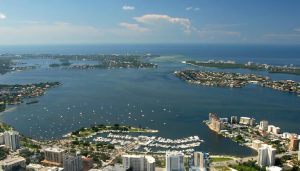 Last month, the Sarasota-Manatee residential real estate market showed an increase in the number of closed sales and pending sales, a continuation in the rise of median prices and a drop in inventory levels.
Last month, the Sarasota-Manatee residential real estate market showed an increase in the number of closed sales and pending sales, a continuation in the rise of median prices and a drop in inventory levels.
Home buyers preferred condos and townhouses over single-family homes, a likely sign that snowbird season has been good for one sector of the residential market.
March condo sales rose 9.9 percent in Sarasota to 454 and 9.7 percent in Manatee to 284 year over year. As for single-family homes, Manatee sales fell 0.2 percent to 580, while Sarasota dropped 2.3 percent to 766.
Closed Sales
In the two-county metropolitan statistical area, closed sales for single-family homes and condos reached 5,015 properties so far this year, a 2.3 percent increase from this time last year. Comparing this past month to March 2017, statistics show a 1.4 percent drop in single-family home sales but a jump in condo sales of 9.8 percent.
“With the close of ‘season’ fast upon us, we are once again showing an increase in combined sales in both counties,” said Greg Owens, president of the Realtor Association of Sarasota and Manatee.
“Pending sales showed a combined 14.9 percent increase from February 2018 to March 2018,” he said. “This increase indicates a strong finish going into summer.”
Median Prices
Year over year, single-family median prices in Sarasota rose by 9.3 percent to $287,053 while Manatee dropped by 1.7 percent to $285,000. The median sales price for Manatee condos jumped by 15.1 percent to $201,500 and Sarasota condos increased by 4.3 percent to $240,000.
Combined, pending sales for single-family homes and condos increased by 4.9 percent from March 2017.
Inventory
The decline in new listings is another good indication of the selling season ending, the association said. The number of properties put on the market during March 2018 fell by 7.6 percent from 2017 in the two-county area. Combined inventory in the two-county area dropped by 14 percent from March 2017. Compared with last year, the supply of single-family homes decreased 15.4 percent, while that of condos fell 11.4 percent.
In single-family homes, Charlotte County showed a 2 percent increase in closed sales, to 411, a 10.2 percent jump in the median sales price and a 0.4 percent rise in pending sales. In townhouses and condos, closed sales jumped by 14.8 percent, the median sales price increased 10.8 percent to $176,250 and new pending sales rose 2.2 percent, to 139.
Florida’s Market
Across the state, March’s tight inventory constrained sales and pushed median prices higher, according to the latest housing data released by the Florida Realtors trade association. Closed sales fell by 3.5 percent, while median prices rose by 8.2 percent year over year.
The statewide median sales price for single-family existing homes last month was $250,800, up 8.2 percent from the previous year, while the statewide median price for townhouse-condo properties was $183,000, up 7 percent over the year-ago figure.
“As the ongoing supply of for-sale homes continues to tighten, it can create a cycle of frustration for home buyers, especially those trying to become a first-time homeowner,” said 2018 Florida Realtors President Christine Hansen, broker-owner with Century 21 Hansen Realty in Fort Lauderdale. “If move-up buyers can’t find a home in their desired price range, then they aren’t likely to leave their current home, which in turn makes entry-level properties even more scarce.
“Buyer demand is high, but the shortfall of inventory — particularly around $250,000 and under — is impacting affordability in many areas.”
March was the 75th consecutive month that the statewide median sales prices for both single-family homes and townhouse-condo properties rose year-over-year.
National Numbers
Across the country, existing-home sales increased for the second consecutive month in March, but lagging inventory levels and affordability constraints kept sales activity below year ago levels, according to the National Association of Realtors. Despite the increase, March sales were still 1.2 percent below a year ago.
“The unwelcome news is that while the healthy economy is generating sustained interest in buying a home this spring, sales are lagging year ago levels because supply is woefully low and home prices keep climbing above what some would-be buyers can afford,” Lawrence Yun, NAR chief economist, said in a press release.
The median existing-home price for all housing types in March was $250,400, up 5.8 percent from March 2017 ($236,600). March’s price increase marks the 73rd straight month of year-over-year gains.
Housing affordability is down from a year ago and fewer households can afford the active inventory of homes currently for sale on the market based on their income. That is according to joint research from the National Association of Realtors and realtor.com, an online real estate destination.
Using data on mortgages, state and metro area income and listings on realtor.com, the Realtors Affordability Distribution Curve and Score is designed to examine affordability conditions at different income levels for all active inventory on the market. A score of one or higher generally suggests a market where homes for sale are more affordable to households in proportion to their income distribution.
According to March data, 35 metro areas had better affordability compared to a year earlier, led by Austin-Round Rock, Texas, (from 0.55 to 0.66), Syracuse, New York, (1.04 to 1.1) North Port-Sarasota-Bradenton, (0.60 to 0.66) and Palm Bay-Melbourne, (0.71 to 0.77).
Sarasota Herald-Tribune April 23, 2018
